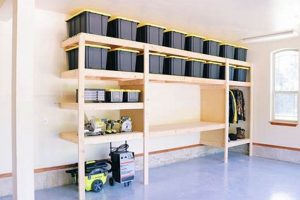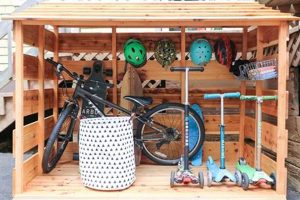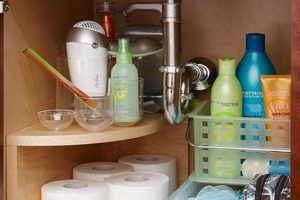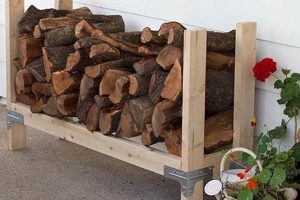Creation of storage solutions designed for the space beneath a bed, accomplished through do-it-yourself methods, represents a practical approach to home organization. For example, constructing custom-sized containers from wood or repurposing existing drawers with added casters fall under this category.
Such projects maximize underutilized areas within the home, contributing to reduced clutter and improved spatial efficiency. Historically, adapting furniture for storage has been a common practice, reflecting a resource-conscious approach to interior design and space management.
The subsequent sections will delve into material selection, design considerations, construction techniques, and project ideas relevant to optimizing storage capacity beneath beds.
Under the Bed Storage DIY
Optimizing space beneath a bed requires careful planning and execution. The following tips provide guidance for successful project implementation.
Tip 1: Measure Accurately. Precisely determine the available height and width under the bed frame. Incorrect measurements will result in ill-fitting storage solutions.
Tip 2: Consider Accessibility. Factor in ease of access to the storage units. Rolling casters or integrated handles enhance usability, especially for heavier items.
Tip 3: Prioritize Material Selection. Opt for durable materials that can withstand weight and resist wear. Solid wood or reinforced plastic are suitable choices.
Tip 4: Optimize Vertical Space. Employ stackable containers or tiered shelves within the storage units to maximize the utilization of vertical space.
Tip 5: Label Contents Clearly. Affix clear labels to each container to facilitate easy identification of stored items. This streamlines retrieval and reduces unnecessary searching.
Tip 6: Implement Dust Protection. Incorporate features such as lids or covers to shield stored items from dust accumulation. This helps maintain cleanliness and prolongs the lifespan of stored materials.
Tip 7: Utilize Dividers. Internal dividers help to organize items within larger storage containers. This is especially useful for clothing, linens or smaller accessories to prevent them from shifting and mixing together.
Tip 8: Choose Low Profile Designs. Designs with a lower height and wider base will be more stable and less likely to tip over when being used. Also, ensure all components are securely fastened to prevent parts from detaching over time.
Adhering to these guidelines will contribute to the creation of efficient and well-organized storage beneath the bed, leading to a more functional living space.
The concluding section will summarize the key advantages and offer final recommendations for realizing optimal space utilization.
1. Dimensions
The dimensional aspect is fundamental to successful implementation of under the bed storage. Accurate measurement and consideration of spatial constraints are paramount to ensure seamless integration and optimal utilization of the available area.
- Bed Frame Clearance
The vertical clearance between the floor and the bed frame constitutes a primary dimensional constraint. This height dictates the maximum vertical size of storage containers, thereby limiting the types of items that can be stored. Insufficient clearance renders the space unusable for standard storage solutions.
- Bed Width and Depth
The width and depth of the bed frame define the horizontal boundaries of the storage area. These dimensions influence the number and size of storage units that can be accommodated. Overestimating these values can lead to units that protrude beyond the bed’s footprint, obstructing movement and compromising aesthetics.
- Internal Container Dimensions
Within the overall dimensions, the internal dimensions of the storage containers determine the usable storage volume. Optimizing these dimensions allows for efficient organization and prevents wasted space. For instance, utilizing rectangular containers maximizes space compared to irregularly shaped alternatives.
- Maneuverability Space
Adequate space must be considered for maneuvering the storage containers in and out of the under-bed area. This includes allowing for hand clearance and the arc of any rolling mechanisms. Failure to account for this space can result in difficulty accessing stored items and potential damage to the bed frame or surrounding floor.
These dimensional considerations, when addressed proactively, contribute to a practical and efficient under the bed storage solution. Accurate assessments ensure that the final construction meets the specific requirements of the available space, maximizing its utility without compromising accessibility or aesthetics.
2. Materials
Material selection is a critical determinant of the success and longevity of any under the bed storage DIY project. The chosen material impacts structural integrity, weight capacity, aesthetic appeal, and overall usability. For example, constructing a large storage drawer from flimsy cardboard would result in premature failure under normal loading conditions, whereas solid wood or high-density polyethylene would provide robust support. Therefore, the intended load, frequency of use, and environmental factors within the storage space must be considered when selecting materials.
Furthermore, the material dictates the ease of construction and the necessary tools. Working with plywood requires different cutting and fastening techniques than working with fabric or metal. For example, a project involving wooden boxes might necessitate access to a saw, drill, and appropriate fasteners, whereas a fabric-based solution could rely on sewing or gluing. The material’s resistance to moisture and pests is equally important, especially in environments prone to humidity or insect infestation. Consider the use of moisture-resistant lumber and sealed containers to mitigate such risks. Repurposed materials, such as old dresser drawers or plastic bins, can offer cost-effective solutions, but require thorough cleaning and preparation before use.
In summary, material selection is integral to under the bed storage DIY initiatives. Thoughtful consideration of structural requirements, environmental conditions, and ease of construction ensures a durable, functional, and aesthetically pleasing storage solution. Failure to prioritize appropriate materials can lead to structural deficiencies, reduced lifespan, and ultimately, project failure.
3. Accessibility
Accessibility represents a critical design parameter in under the bed storage DIY projects, influencing the utility and user-friendliness of the resultant storage system. The ease with which stored items can be retrieved and replaced directly impacts the effectiveness of the space-saving solution. For example, containers positioned at the back of the under-bed area without a mechanism for effortless retrieval negate the benefits of enhanced storage capacity, as accessing these items becomes cumbersome.
Incorporating features that enhance accessibility directly addresses these challenges. Roll-out drawers with smooth-gliding casters allow for easy access to items regardless of their position. Handles or grips on storage boxes facilitate effortless pulling and maneuvering. Lids or closures that can be readily opened or removed further streamline the process of retrieving and storing items. These design choices, while seemingly minor, significantly enhance the overall usability and practicality of the system. For instance, clear labeling of containers enables quick identification of contents, reducing search time and minimizing disruption.
Ultimately, prioritizing accessibility in under the bed storage DIY transforms an area of potential inconvenience into an organized and readily usable space. This focus not only improves the efficiency of storage but also encourages consistent use of the system, thereby maximizing its long-term benefits. Without due consideration of accessibility, an under-bed storage solution, however well-constructed, risks becoming an underutilized and frustrating component of the living space.
4. Mobility
Mobility constitutes a crucial factor in the practical design and implementation of under the bed storage DIY solutions. The capacity to easily move or reposition storage units beneath a bed directly impacts their functionality, user-friendliness, and overall efficiency.
- Casters and Wheels
The integration of casters or wheels onto under bed storage units facilitates effortless movement across various floor surfaces. This feature is particularly beneficial for accessing items stored at the back of the under-bed space, as it eliminates the need for strenuous pulling or lifting. For instance, a low-profile storage bin equipped with heavy-duty casters can be readily rolled out for access, even when fully loaded. Furthermore, casters enable easy repositioning of storage units for cleaning or rearrangement of the room.
- Lightweight Construction
The overall weight of under bed storage units significantly influences their maneuverability. Utilizing lightweight materials such as plywood, fabric, or plastic reduces the effort required to move the units. This is particularly important for individuals with limited physical strength or mobility. For example, constructing storage containers from lightweight canvas or breathable fabric can significantly enhance their ease of handling and repositioning.
- Handle Placement and Design
Ergonomically designed handles, strategically positioned on under bed storage units, contribute to improved grip and control during movement. Handles should be robust enough to withstand the weight of the loaded units and positioned to minimize strain on the user. Recessed handles, integrated into the sides of storage boxes, provide a secure grip while maintaining a low profile. The implementation of comfortable and properly placed handles can increase the practicality of moving the storage unit.
- Glide Strips and Runners
The application of glide strips or runners beneath under bed storage units, particularly those without casters, reduces friction and facilitates smoother movement across the floor. These strips, typically made of plastic or felt, minimize scratching and damage to the flooring while enabling easier sliding of the storage units. This approach is especially suitable for hardwood or laminate floors where protecting the surface is a primary concern. These also enable quiet movement.
Incorporating mobility-enhancing features into under the bed storage DIY designs optimizes accessibility, reduces physical strain, and contributes to a more user-friendly and functional storage solution. The selection of appropriate mobility mechanisms depends on factors such as floor type, weight of stored items, and the user’s physical capabilities. Therefore, careful consideration should be given to mobility during the planning and construction phases of any under the bed storage DIY project.
5. Organization
Organization serves as a foundational principle in the effective application of under the bed storage DIY. The successful implementation of such storage solutions hinges upon the ability to categorize, contain, and readily access stored items, thereby optimizing space utilization and minimizing clutter.
- Categorization and Sorting
Effective organization necessitates the preliminary step of categorizing items based on their type, usage frequency, or any other relevant criteria. This allows for the allocation of designated storage spaces tailored to specific categories. For instance, seasonal clothing might be grouped together, while frequently used items are stored in easily accessible containers. This systematic approach enhances retrieval efficiency and prevents the indiscriminate mixing of disparate items.
- Containerization and Modularity
Employing a modular system of storage containers promotes organization by providing defined spaces for various categories of items. These containers can be standardized in size and shape to maximize space utilization and facilitate stacking or arrangement. Utilizing clear containers or labeling systems further enhances visibility and allows for quick identification of contents without the need for extensive searching. The selection of appropriate container types, whether rigid boxes or flexible bags, should be guided by the specific characteristics of the stored items.
- Spatial Arrangement and Accessibility
The spatial arrangement of storage units beneath the bed significantly impacts accessibility and overall organization. Items that are frequently used should be positioned towards the front of the storage area, while less frequently accessed items can be stored further back. Optimizing the layout to accommodate the size and shape of different items maximizes the use of available space. Furthermore, ensuring sufficient clearance for accessing and maneuvering storage containers is essential for maintaining a functional and organized system.
- Maintenance and Regular Decluttering
Organization is an ongoing process that requires regular maintenance and decluttering. Periodically reviewing the contents of under the bed storage, discarding unwanted items, and reorganizing existing items helps prevent the accumulation of clutter and ensures that the storage space remains optimized. Implementing a regular decluttering schedule, such as seasonally or annually, can prevent the system from becoming disorganized and less efficient over time.
In conclusion, organization is not merely a supplementary aspect of under the bed storage DIY; it is an intrinsic component that determines the efficacy and sustainability of the storage solution. Through thoughtful categorization, containerization, spatial arrangement, and regular maintenance, under the bed storage can be transformed from a potential source of clutter into a valuable asset for enhancing space utilization and promoting a more organized living environment.
6. Dustproofing
Dust accumulation beneath beds constitutes a significant concern for stored items, necessitating effective dustproofing strategies in under the bed storage DIY projects. The accumulation of dust, composed of particulate matter, skin cells, and other debris, can degrade stored materials over time. Fabrics may fade or become discolored, paper-based items may become brittle, and electronic components may malfunction due to dust ingress. Therefore, integrating dustproofing measures is crucial for preserving the integrity of stored items. For example, an open storage bin containing seasonal clothing will inevitably accumulate dust, potentially requiring cleaning before use. In contrast, a sealed container will prevent dust ingress, maintaining the clothing’s cleanliness and condition.
Practical implementation of dustproofing measures encompasses several techniques. Utilizing storage containers with tight-fitting lids forms a primary defense against dust intrusion. Materials such as plastic or wood offer greater protection compared to open-weave fabrics. Sealing gaps around container edges with adhesive strips or weather stripping further enhances dust resistance. Vacuuming or dusting the under-bed area regularly minimizes the source of dust, reducing the potential for accumulation within storage units. Furthermore, elevated storage units, achieved through the use of legs or platforms, create a buffer zone, minimizing direct contact with dust-laden floor surfaces.
In conclusion, dustproofing represents an indispensable element in under the bed storage DIY. Neglecting dustproofing measures can lead to damage and degradation of stored items, negating the benefits of organized storage. By incorporating appropriate dustproofing techniques, the lifespan of stored items is extended, and the overall effectiveness of the under the bed storage system is significantly enhanced. The challenge lies in selecting dustproofing methods that balance protection with accessibility and cost-effectiveness, ensuring a practical and sustainable storage solution.
7. Weight Capacity
Weight capacity is a paramount consideration in under the bed storage DIY projects, directly influencing structural integrity, safety, and the long-term viability of the storage solution. Careful assessment of anticipated loads and material properties is essential for preventing structural failure and ensuring safe operation.
- Material Strength and Support Structure
The intrinsic strength of chosen materials, coupled with the design of the support structure, dictates the overall weight-bearing capability of the under-bed storage unit. For example, a storage box constructed from thin particleboard will exhibit significantly lower weight capacity than a similar design utilizing solid hardwood or reinforced steel. The support structure, including corner bracing, internal dividers, and base reinforcement, further contributes to load distribution and structural stability. Underestimating material strength or neglecting adequate support can result in bowing, cracking, or complete collapse under load.
- Floor Load Distribution
The distribution of weight across the floor is a critical factor in preventing damage to flooring surfaces and ensuring stability. Concentrated loads can exceed the floor’s bearing capacity, leading to indentation, cracking, or even structural damage to the subfloor. Implementing strategies to distribute weight evenly, such as utilizing a broad base or employing multiple support points, mitigates this risk. Consideration must be given to the floor type and its inherent load-bearing capabilities.
- Caster and Hardware Load Ratings
When mobility is incorporated into the design through the use of casters, the load ratings of the casters and associated hardware become a critical determinant of the overall weight capacity. Selecting casters with inadequate load ratings can result in premature failure, leading to instability and potential damage to both the storage unit and surrounding surfaces. Similarly, hinges, handles, and other hardware components must be chosen to withstand anticipated stresses without deformation or failure. The lowest rated component dictates the overall weight capacity of the moving system.
- Safety Margin and Overload Prevention
Implementing a safety margin in the design process provides a buffer against unforeseen loads and ensures structural integrity under varying conditions. Overestimating the anticipated load and incorporating a safety factor, typically expressed as a percentage, accounts for potential variations in weight distribution and material properties. Furthermore, establishing clear weight limits and implementing measures to prevent overloading, such as visual indicators or physical barriers, reduces the risk of structural failure and enhances safety.
These facets of weight capacity, when meticulously addressed, contribute to the creation of durable, safe, and reliable under the bed storage DIY solutions. Failure to consider weight capacity adequately can result in structural compromise, posing potential risks to both stored items and the surrounding environment. Accurate assessment and proactive design measures are paramount for ensuring the long-term success and safety of such projects.
Frequently Asked Questions
This section addresses common inquiries pertaining to the design, construction, and implementation of do-it-yourself storage solutions for the space beneath beds.
Question 1: What factors should be considered when determining the optimal dimensions for under the bed storage containers?
Clearance beneath the bed frame, the size and quantity of items to be stored, and the ease of maneuvering containers in and out of the space should be evaluated. Precise measurements are crucial for maximizing space utilization.
Question 2: Which materials are most suitable for constructing durable and long-lasting under the bed storage units?
Solid wood, plywood, reinforced plastics, and durable fabrics are viable options. Material selection depends on the intended load, environmental conditions, and aesthetic preferences. A thorough understanding of material properties is essential.
Question 3: How can accessibility to stored items be optimized in under the bed storage systems?
Incorporating rolling casters, handles, and clear labeling facilitates easy retrieval of stored items. Positioning frequently used items towards the front of the storage area enhances convenience.
Question 4: What are effective methods for protecting stored items from dust accumulation beneath the bed?
Utilizing storage containers with tight-fitting lids, sealing gaps around edges, and regularly cleaning the under-bed area minimizes dust ingress. Elevated storage units reduce direct contact with floor-level dust.
Question 5: How can the weight capacity of under the bed storage units be maximized while ensuring structural integrity?
Employing robust materials, reinforcing support structures, and distributing weight evenly are essential. Careful calculation of anticipated loads and the incorporation of safety margins prevent structural failure.
Question 6: What safety precautions should be observed during the construction and use of under the bed storage DIY projects?
Wearing appropriate protective equipment, utilizing power tools safely, and adhering to weight limits are critical. Securely fastening all components and preventing overloading minimizes the risk of injury or damage.
These FAQs offer guidance for navigating the complexities of under the bed storage DIY, promoting informed decision-making and successful project outcomes.
The subsequent section will explore specific project ideas and design inspirations for creating customized under the bed storage solutions.
Conclusion
The preceding discourse has comprehensively addressed the salient aspects of under the bed storage diy. From initial dimensional considerations and material selection to accessibility enhancements, dustproofing measures, and weight capacity assessments, the multifaceted nature of designing and implementing effective storage solutions has been extensively explored.
The responsible and informed application of these principles will yield practical and enduring organizational enhancements. Individuals are encouraged to approach these projects with meticulous planning and a commitment to safety, thereby maximizing the utility of underutilized spaces and fostering a more orderly living environment.



![Build Your Own! Storage Bin Rack DIY Project [Easy] The DIY Hub: Creative Crafts, Repairs & Life Hacks Build Your Own! Storage Bin Rack DIY Project [Easy] | The DIY Hub: Creative Crafts, Repairs & Life Hacks](https://craftingdiycenter.com/wp-content/uploads/2025/07/th-1825-300x200.jpg)



